
World Association of
Research Professionals
Vondelstraat 172, 1054 GV Amsterdam, The Netherlands
Tel: +31-20-664 21 41, Fax: +31-20-664 29 22
 |
World Association of | April 2008 |
John Shanahan
Colmar Brunton, Australia
Ray Poynter
The Future Place, United Kingdom
Jason Ho
Asia Pacific, Colmar Brunton, Singapore
INTRODUCTION
Most conversations and presentations about Web 2.0 have focused on Western examples, typically from the United States and Europe. Companies such as P&G, Lego, Albert Heijn, and Unilever tend to get most of the press, along with US-originated services such as Wikipedia, eBay, YouTube, Facebook, and MySpace.
However, this Western focus on Web 2.0 ignores the fact that the largest global Internet footprint is that of Asia. As of late 2007, North America accounted for 19% of all Internet users, Europe 27%, whilst Asia accounts for 37% of all Internet users. Moreover, the growth in the number of Internet users in Asia is much faster than Europe, and nearly three times as fast as North America!1
Similarly, whilst the largest group of Internet users are native English speakers, the second largest group are Chinese speakers, and the growth in Chinese speaking users is much faster than the growth in English speakers.
One of the key debates, over the last few years, has been whether the Internet will: a) drive the world of commerce and international discourse, further, towards English; b) facilitate diversity; or c) allow the Chinese language(s) to take a much larger role. But, most of the discussion has been anecdotal and largely confined to how the Internet is now, as opposed to how it might be.
The biggest buzz in 2007 was the growth of interest in Web 2.0, and the hottest buzz in Web 2.0 was social networking and the social graph. The interest in social networking was initially driven by services such as Friendster and MySpace, but more recently services such as Facebook, Bebo, and Orkut have been getting headlines. Across the globe, social networks are changing the way people communicate with each other. In addition to the big international sites, there are numerous national variations, such as China's 51.com, Korea's Cyworld, and Japan's Mixi.
This paper seeks to shift the focus of the discussion away from the Western markets and to look at what is happening in the Asia Pacific region, and in particular with respect to Chinese language activity.
Key questions addressed by the paper are:
What are the options for using social networks for market research in Asia Pacific?
What are the differences between countries and language groups in terms of social network based research?
To what extent does the current focus on English language research obscure the potential of social network based research?
Are social networks driving homogeneity or heterogeneity in Asia Pacific, and what are the implications for market research?
The paper starts by conducting an extensive review of secondary data sources and then introduces a number of experiments conducted by the authors, as part of an ongoing research programme.
Caveat Re Data Sources
Different providers of data produce very different estimates of apparently similar phenomena. The authors have chosen the data sources for this project by balancing two elements, does the data source include the key players in Asia (some only focus of Western countries, some only on the United States), and the degree of general criticism/support for that source.
For our overall Internet statistics we have used InternetWorldStats.com, which in turn draws its data from a range of sources.
For data about the popularity of websites we have used Alexa.com. However, we are aware that many people are unhappy with the figures produced by Alexa, particularly in the United States. Alexa's figures are dependent on how many people have downloaded their toolbar, and who are therefore submitting data to Alex's central databases. However, Alex has better coverage of Asia/Pacific than other sources.
INTERNET USERS AND PENETRATION
When assessing the impact of a country on the Internet, and of the Internet on the a country, we need to address two statistics, the total number of Internet users and the number of Internet users as a percentage of the country's total population. The second statistic is usually referred to as the penetration.
The sections below look at differing patterns of Internet usage by region and by country.
Internet Usage by Region
Table 1 shows the number of Internet users (in millions) for each region, the Internet penetration in each region, and the growth from 2000 to 2007.

Table 1
Figure 1 shows the Internet usage and penetration data in two dimensions.

Figure 1: Internet users and penetration
Table 1 and Figure 1 both show that whilst Asia has the largest number of Internet users, it has a relatively low level of Internet penetration. However, the growth in the number of Internet users in Asia is almost three times as fast as the growth in North America. The implication of these figures and trends is that Asia will soon account for more users than North America and Europe combined. Indeed, is widely assumed that China will have the largest number of Internet users, before the end of 2008, overtaking the United States.
Internet Usage by Country
Table 2 shows the Internet usage and penetration for the twenty countries with the highest number of Internet users.

Table 2
Table 2 shows that four of the eight countries with the largest numbers of Internet users are in Asia, but these countries have very different Internet penetrations. Japan and Korea have penetrations of 67%, whereas China has 12% and India just 4%.
It easy to make the assumption that developed countries have more developed Internet infrastructures. However, this is not necessarily the case. In India only 5% of
Internet users are accessing it via broadband, which will limit the range of services that can be used. However, the percentage of Chinese users connected via broadband is just behind the United States, Germany, Italy, and Australia, but well behind South Korea – who have long led the way with high speed connections.
The Economist (2008) has highlighted that the way the Internet is developing in China is different from the way it has developed in more advanced economies. China, like other developing economies, has played leapfrog, ignoring the development of copper-based land lines, ignoring low specification mobile phones, and have started (in many cases) using broadband and modern mobile phone standards. China has over 524 million mobile phone users, more than half of them buying ringtones, jokes, and picture from Internet portals such as KongZhong and Tom Online.
In China, the Internet has different constraints, some cultural, some economic, and some political. Many Western sites are censored, in other cases they cooperate with self-censorship. Payment terms are highly regulated, so many of the Western options are not available, and some of the Western perceptions of copyright are less enforced in China.
THE 2.0 PHENOMENA
The range of nouns and verbs that have had the 2.0 suffix added to them seems to grow day-by-day, including Law 2.0, Identity 2.0, Insight 2.0, and of course Research 2.0.
Web 2.0
All of the 'lesser' 2.0 phrases stem from Web 2.0, a phrase which is, itself, somewhat hard to pin down, but which dates back to 2004. If you type “Web 2.0” into Google, you will see are about 21 million hits. Some people prefer to define Web 2.0 in terms of changes in the technology, particularly the rise in approaches like AJAX (Asynchronous JavaScript and XML) which have allowed pages to be dynamic without having to submit the form back to the server for updates. Others point towards specific changes in the sorts of programs and services that people prefer to use. For example, Tim O'Reilly (one of the people associated with the coining of the term Web 2.0) uses a table similar to Table 3 to illustrate the difference between 1.0 and 2.0.
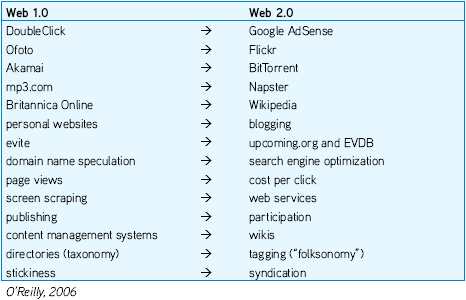
Table 3
The authors' definition of 2.0 is based on the concept that 'Anything 1.0', was about one-way communication. For example, editors published and people read, brands marketed and people bought (any colour as long as it was black), politicians spoke and people were ruled, market researchers surveyed and respondents responded. By contrast 'Anything 2.0' is a two-way communication, it is about commenting, co-creating, reviewing, collaboration, sharing, modifying, and personalising.
Research 2.0
The term Research 2.0 dates back to about 2006 and refers to the way that market research has responded to the challenges created by Web 2.0, and the underlying societal changes that have driven changes such as co-creation, Wikinomics, The Long Tail, and the whole 2.0 phenomenon.
As Ray Poynter commented in Research World, “Research 1.0 was something we did to people; Research 2.0 is something we do with people.” Graeme Trayner has described the traditional research paradigm as being “command and control” and Pete Comley has used Transactional Analysis to show that the traditional Web and traditional market research were both based on Adult <> Child relationships, whereas Web 2.0 and Research 2.0 are both based on Adult <> Adult relationships.
The term Research 2.0 has been applied to a wide range of approaches including: blogs for qualitative research, blog mining, research communities, opinion leader communities, and allowing respondents to amend and adapt questionnaires.
Social Networks
Social networks is a generic term for sites such as MySpace, Facebook, qq, CyWorld, and Mixi. The key element of social networks is the ability to have a profile or home space, the ability to have a list of friends, the ability for your friends to introduce themselves to other people on your list of friends, and messaging.
Four of the top ten sites listed on Alex's global ranking (17/1/2008) are pure social network sites (i.e. MySpace, Facebook, Hi5, and Orkut) and several of the others have increasingly strong social network elements, such as Yahoo!, YouTube, and MSN.
Different social networks have done well in different countries. For example, Facebook is particularly strong in the United Kingdom, Canada, and Turkey, Orkut is dominant in Brazil, Mixi in Japan, Cyworld in Korea, and China has its leaders with sites such as qq, 51.com and Xiaonei.
The most interesting developments in social networks in the last year or so have all related to the opening up of interfaces. These changes have included the growth in 'white label' social networks such as Ning, the opening of interfaces to allow third-party applications, and the creation and promotion of Open Social.
Social Networks and Market Research
There has been a growing amount of interest in using social networks for market research since early 2007. Ray Poynter has highlighted the changes that are happening with respect to Facebook (IJMR 2008), but the changes apply to the wider growth in social networks.
One key bit of language that traditional market researchers need to get used to, when they engage with social networks, is the difference between a poll and a survey. Despite the fact that researchers may feel they have owned the term poll for many decades, in the world of social networks the term poll refers to an exercise with a single question, typically with a small number of closed responses.
Researchers have created discussion groups in social networks, they have used social networks to recruit respondents for qualitative research, and brands such as Skittles have set up Facebook groups to connect with users, including the use of polls and surveys conducted outside Facebook.
Facebook has integrated a commercial facility into their system to provide Facebook Polls, a service which asks single question surveys (i.e. polls) to highly targeted groups of members.
Peanut Labs have morphed their social network into a cross-site research service, where clients can place surveys, particularly those targeted at Gen Y consumers, and which are delivered across a range of social networks. Companies such as GMI have been experimenting with embedding panel management applications within social networks such as Facebook and more recently via Open Social.
In many ways, social networks for market research is in its infancy, rather like using the Internet for market research was in the mid-1990s.
WEB 2.0 IN ASIA PACIFIC
Overview of Web 2.0 Sites
Table 4 shows the top 10 sites, as ranked by Alexa in terms of traffic 12/1/2008, for Australia, China, Hong Kong, and Singapore.
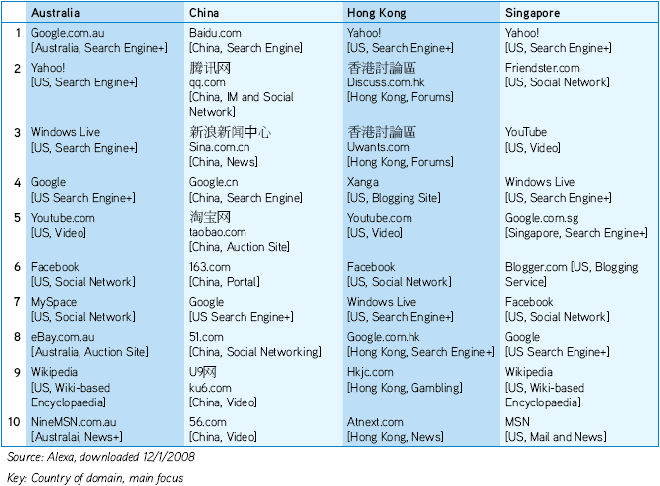
Table 4
According to Alexa, Facebook was 81st in China, whilst MySpace, Xanga, Orkut, and Bebo did not appear in the top 100. Facebook imitation Xiaonei was ranked at 48, well ahead of Facebook, but well behind the leading Chinese sites – according to Alexa.
Table 4 illustrates the way that Web 2.0 sites, i.e. those with significant levels of user created material and interaction, are dominating in all four countries. Even the search engines and portals are becoming increasingly 'social' through extensions and facilities to share bookmarks and links.
Video uploading and sharing is strong in all markets, but whilst it is YouTube in Australia, Hong Kong, and Singapore, there are many more alternatives in China.
Yahoo! is in the top two most visited sites in Australia, Hong Kong, and Singapore, but does not make the top ten in China (Yahoo.com.cn being 16th and Yahoo. com 24th).
The biggest difference between China and the other three countries is the dominance of Baidu, which is not only ranked number 1 in China, but 20th globally. Similarly qq.com is ranked very high globally (28th) despite being effectively a domestic brand.
In many ways, the strength of sites such as Baidu and qq.com is reminiscent of the way that Japanese brands such as Sony, Toyota, and Honda were developing in the 1950s and 1960s. However, the key difference between Japan and China is that China is 10 times larger than Japan.
Web 2.0 in China
Liu and Zoninsein (2007) observe that social networks in China tend to be more numerous in number and more focused on Instant Messaging than is typical in Western societies.
Data from Media-Screen (see Figure 2) suggest that young (under 35 year old) Chinese Internet users are more Web 2.0 active than their US counterparts.
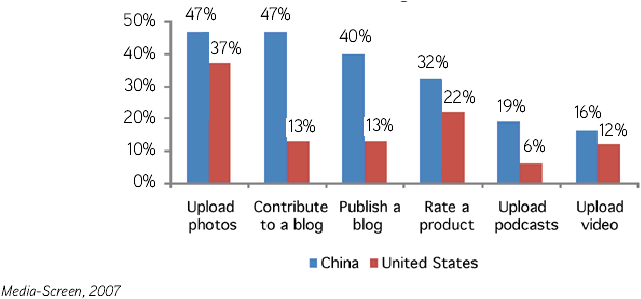
Figure 2: The young pioneers
Mark Sweeney (2007) reviews research by IAC and JWT (which compared Internet users in China and the United States) and concludes that young Chinese Internet users are embracing the Web to a greater extent than their US counterparts. He highlights the following differences:
61% of Internet users in China agreed they had a “parallel life” online, whereas only 13% of Internet users in the United States said the same.
50% in China said they were regular visitors of blogs, compared with just 16% in the United States.
Young US users often see the Internet as a way of achieving fame, this is much less a desired aim for many Chinese users, presumably this is partly to do with the Chinese political system, but it may also reflect cultural differences. 79% in China said it is good to be able to express anonymous views online, compared with 42% in the United States.
40% of Chinese users admitted they sometimes feel addicted to living online, compared with just 18% in the United States.
Note the IAC/JWT study produced different age profiles in China and the United States, the users in China were much younger, with an average just over 20 years old, and this may have affected the comparisons.
The comments of Diller (2007), from IAC, are very illuminating. “The Chinese people seem to be way ahead of Americans in living a digital life ...” and “Like many other areas in comparing Americans to the energy and progress elsewhere in the world, China's speedy evolution in its use of the internet is fast eclipsing that of the US”.
China View reports that by the end of 2007 there were 47 million bloggers in China (based on a poll by China Internet Network Information Center (CINIC) of 1,862 netizens in late November). The study also indicated that 55% of bloggers were female. This is another piece of evidence that Chinese Internet users are more Web 2.0 oriented than their Western counterparts.
Gang Lu, 2008, identified that one aspect of China's social networking is very different from that of other countries, namely the strength of traditional forums, or BBS. Gang Lu estimates that 80% of Chinese sites are running their own BBS – which in effect means 80% have some degree of user generated content. Gang Lu puts forward the proposition that BBS are topic focused whilst social networks are people centric. In China, at the moment, both are important, the Internet is used socially, but it is used as an important tool by current users.
Amongst the many possible reasons why Chinese Internet users seem to have embraced the social Web more fully, it has been suggested that China's one child policy could have had an impact. It is suggested that the absence of siblings may have whetted appetites for an extended virtual family.
Search Engines and Chinese
A report by Enquiro looked at the different eye tracking results for a typical Google page in the United States (using English), with Google China and Baidu.
The research conducted by Enquiro looked into different eye tracking patterns when users viewed three different search engine pages. The first page was a standard Google page, viewed in the United States. The second page was a Chinese Google page, viewed in China, and the third page was a Baidu page viewed in China.
The Enquiro data shows that the US Google users focused very heavily in the top left part of the page, in a pattern familiar to anybody who has seen plenty of eye-tracking data. The Google China page still shows that the top left is the most viewed area, but the hotspots are less focused. By contrast the Baidu page showed a much wider range of hotspots, the top left was the most viewed but all of the left hand side of the page recorded significant viewings.
The Enquiro data suggest that there are differences both between Chinese and US viewers and between a page laid out by a Chinese company and a US company. The research also suggests that differences may increase in the future, because at present most templates and tools are still based on western models.
THE LINGUA FRANCA?
The definition of lingua franca in Wikipedia (at 9/1/2008) is particularly apt. “A lingua franca ... is any language widely used beyond the population of its native speakers. The de facto status of lingua franca is usually 'awarded' by the masses to the language of the most influential nation(s) of the time.”
One key question is whether the Internet is leading to an English hegemony or facilitates the growth of competing languages? Although, the jury is still out on this issue, the strength and growth of CyWorld and Korea, Mixi in Japan, and many social networks in China suggest that English is not about to establish a monopoly any time soon.
Comparison of Chinese and English Usage in Search Engines
Xiao Qiang has produced an analysis of the search phrases typed in English in Google and in Chinese into Baidu (the leading Chinese language search engine). Table 5 shows the top ten, global, “What is” questions typed into Baidu, the top ten typed into Google. Google is the leading global search engine and Baidu is the word's leading Chinese language search engine.
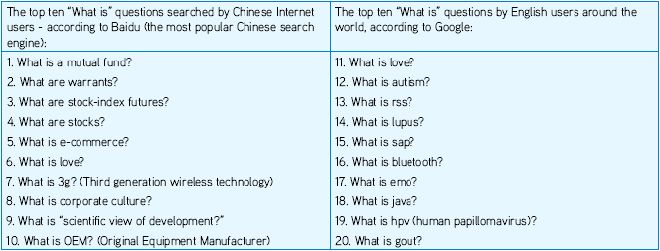
Table 5
Table 6 shows the top ten “How to” questions typed into Baidu and Google.

Table 6
The two lists of top ten items have some elements that are similar. For example, “How to kiss” makes the top ten how to in both English and Chinese language searches. These similarities might be seen as an indication that the world is becoming more homogenous. The big difference between the two languages is that the Chinese language searches contain many more finance and business related searches. This will partly reflect the fact that Chinese speaking users tend to have a profile which is both younger and more relatively affluent than the profile of English language users, but may also reflect a different balance between leisure seeking and information seeking between Chinese and English language Internet users.
Table 7 shows the most popular search terms for Google in China and Hong Kong.
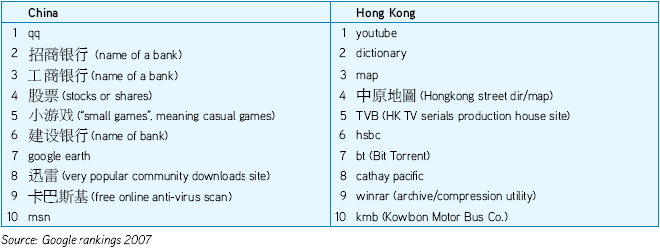
Table 7
Table 7 again illustrates that searching in China tends to be more focused on functional and aspirational (at least in a financial sense), compared with other countries.
One interpretation of the apparent difference between the West and China is that the West has matured beyond Maslow's basic needs of the physiological and safety and have started to value love, belonging, and self-actualisation, whilst China is still at the early stages, i.e. the lower tiers of Maslow's pyramid.
An alternative suggestion is that China is a society on an upload trajectory, whilst the West is sliding into its post-epoch phase, with echoes of the decline and fall of the Roman Empire.
Conducting Research in English Only
There seems to be a growing trend for international Internet market research projects to be conducted in English, with no other languages used. For example, at the MRS Online Conference in London, December 2007, there were three presentations which had adopted this method. P&G and MarketTools talked about their Hairsay community, which has been used for 18 months to conduct global discussions about various hair related topics. Flamingo International and Visit Scotland talked about an online qualitative study conducted in the Middle East, entirely in English. The third study, an online research community created by BA and Virtual Surveys, looked at the views of a sample of BA's global customers about a range of possible IT related service improvements. In two of these studies the merits of using English (in addition to benefits of the cost and time savings) were readily clear. Visit Scotland's core market in the Middle East are people with money who are thinking of, or who could readily be persuaded to, visit Scotland. Unlike people who might visit London, most visitors to Scotland will have some command of English. The BA research was conducted amongst customers of BA who had already conducted some correspondence with them in English.
Clearly, an English only approach is a trade-off between competing requirements. When considering local languages versus English a client has three parameters which they need to trade-off: speed, cost, and quality (which for the purposes of this paper the authors take to include insight).
In traditional market research, translation was a significant cost and time constraint, but not one of the major ones. However, in projects where the cost of the fieldwork falls, and where the degree of interaction increases, translation becomes a much bigger constraint. For example, if the client wants to conduct an international research forum, the moderators will need to speak the language of the forum and the forum members will need to be able to read and write the language of the forum. Translations are needed several times a day, rather than at just the start and end of the project.
The key disadvantage of using one language, typically English, is the loss in quality. In any market, not using the local language, or languages, will reduce the ability of the research to reach people, and it will reduce the ability of the research to answer the key research objectives.
One issue that needs to be explored, in the context of market research, is whether a consumer may adopt different personas when answering in different languages. For example a Mandarin speaking resident of Beijing may appear very Western if taking part in a discussion on Facebook in English, but less so in another discussion on qq.com in Chinese.
The rise of Chinese on the Web
As the number of Chinese Internet users has grown, so has the presence of the Chinese language on the Web. For example, Alexa's global ranking puts Baidu.com (the Chinese search engine) as the 18th most used site (as of January 2008), despite that it is largely unknown outside China.
Table 8 shows the top ten languages amongst Internet users. Note that this is not the same as the languages of the pages, and the authors of the table had to make quite a few assumptions about the data from multi-language countries.

Table 8
However, it may well be that the rise in online, interactive translation tools mean that the language that copy is written in becomes moot, with authors choosing one language, and readers opting to read it in another.
A similar discussion, about the use of English, is also taking place in marketing circles, with people noting the success of websites such as Yahoo!.com, Google.com, and of course Facebook.com. The Beijing Olympics, to be held later this year, could well create a crucible for the assessment of the use of English in China.
EXPERIMENTS WITH SOCIAL NETWORKS
The authors are currently involved in an ongoing research project looking at the use of social networks in the Asia Pacific region, some of which is reported in this section of the paper.
One of the projects currently underway consists of a number of experiments with Facebook Polls and these are reported in the sections below.
Scope and Context
At the outset, it is necessary to underline the scope and context for these experiments. Nobody asserts that, at present, Facebook Polls provide a credible or viable method of conducting commercial market research. The issue being addressed by the experiments reported here is to ascertain the scale of the problems with this sort of approach, and to identify what needs to be solved before social network based quantitative research can form part of the mainstream of market and social research.
What is Facebook Polling?
Facebook polling is a commercial service offered by Facebook. Users can design a simple poll and choose a target audience (for example by age, sex, or location), and Facebook will then deliver the poll via its advertising platform. At the time of the experiments reported below, Facebook Polls were very limited, but the authors expect that this will change during 2008. The current limitations are:
A poll only allows a single question to be asked;
The answers list can only contain up to five closed options;
The respondent can pick only one answer, i.e. it is a single, not a multi;
The data only contain the question responses, plus age, sex, and country.
Although the limitations above are large, there are two benefits of Facebook Polls. Firstly, they are very quick; the experiments reported below all ran within a few hours of being commissioned. Secondly, they are very cheap, each cell of 100 interviews cost just US$26.
Experiment 1 – Accuracy and Language, China
The first experiment looked at the difficulties experienced when trying to use Facebook Polls to produce results that reflected the broader market and also at the impact of using English as opposed to a local language.
The experiment was conducted in China in January 2008. In future research we propose to run identical questions via Facebook Polls and on representative omnibus panels to more fully explore the biases inherent in Facebook Polls. However, for this initial experiment we chose a topic where we 'knew' the correct answer from an alternative source.
The question asked was:
“Which of the following websites/services do you use the most?”
The five websites that comprised the answer list were:
Baidu (a Chinese search engine)
qq.com (an IM and social network)
Sogou.com (a Chinese search engine)
blogchina.com (blog hosting site)
Yahoo! (US site and yahoo.com.cn, the Chinese version)
Key about this list is that we knew, in advance, that Baidu is the most heavily and commonly used site in China. This information is available from Alexa and from other sources. Similarly blogchina.com is the least used of these five sites.
Two versions of the poll were used, one cell where the question was in English, and where the sites were listed in the characters used for their preferred branding. The second cell used Chinese throughout, for both the question and the brands names.
From the outset, the authors were aware that English language questions were likely to be viable, if not representative, because Facebook is currently only available in English. This means that China-based members will have navigated through the registration process in English, which in turn implies that many of them can read English.
Table 9 shows the five answers, their representation in the two cells, and their Alexa rank.

Table 9
Note, both Yahoo.com and Yahoo.cn are major sites in China, and it seems plausible that responses to the poll could relate to either or both Yahoo! sites.
Two cells of 200 interviews were collected using, both the English and Chinese questions, i.e. 400 responses in total.
The first issue the authors examined was the age and sex characteristics of the samples. One concern about a social network sample is whether it will only attract young people.
Table 10 shows the age and sex characteristics of both cells, and the concern about the age of the sample is certainly supported by this experiment.
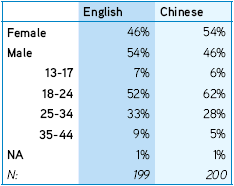
Table 10
About 90% of the sample were aged 18–34 years, with most of them being aged 18–24. This is not necessarily a problem, if one is seeking to research this age group, but it does raise further questions about the general use of social network samples. One of the leading users of social network samples in the United States is Peanut Labs, and they actively promote their system as being suitable for targeting Gen Ys, i.e. 18–24 year olds, and by implication less suitable for anything else.
Table 11 shows the websites which the two cells said were their main sites. The results show both encouraging and worrying elements.
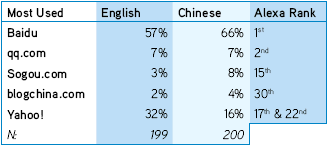
Table 11
Both cells correctly identify Baidu as the most used site, and both cells correctly identify blogchina.com as the least likely to be somebody's main site. Note, blogchina's ranking of 30th means that is not a tiny site, simply the smallest in this test.
The fist negative point is the low score for qq.com in both sites. This is clearly a result of using a Facebook sample. The qq.com site has two main strengths, firstly
IM (Instant Messaging) and secondly as a leading social network. Since the sample comprised users of the Facebook social network, it is unlikely that many of them would cite another social network as their main website.
The second negative relates to the differential score for Yahoo! between the English and Chinese language cells. However, it is not immediately apparent whether the English cell over-states the Yahoo! score, or the Chinese cell understates. Amongst the various biases at play it seems reasonable to assume:
The English cell may have attracted more respondents who are comfortable with English language and who are therefore more likely to be users of Yahoo.com.
The Chinese language poll represented Yahoo! as  . Whist this is correct, for example Yahoo! China is
. Whist this is correct, for example Yahoo! China is  and/or
and/or  the standout of the roman script “Yahoo!” in the English cell could make it easier to spot and recall, particularly for people who tend to use Yahoo.com rather than the Chinese version.
the standout of the roman script “Yahoo!” in the English cell could make it easier to spot and recall, particularly for people who tend to use Yahoo.com rather than the Chinese version.
Table 12 shows the website data for just the 18–24 year olds.
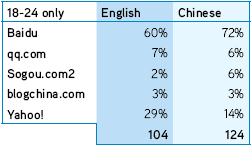
Table 12
Looking just at the 18–24 year olds, we see that the picture is very similar to that for the whole sample. Baidu is the clear leader, blogchina.com is small, qq.com is under-represented, and the difference between the responses for Yahoo! is still present.
This first experiment has illustrated the dangers of using social networks for polling, but it has also indicated that there could be projects for which they are useful, particularly for Gen Y type projects, provided that care is taken over issues such as the specific biases associated with being a user of a particular service.
Experiment 2 – Accuracy and Language, Hong Kong
This experiment was a smaller scale repeat of Experiment 1, conducted in Hong Kong, with two cells of 100 interviews. There are, of course, many differences between Hong Kong and the rest of China, one of which is the number of native English speakers. Over 3% of Hong Kong's population are native English speakers, and English is very well established.
Table 13 shows the demographics of the sample from Experiment 2.
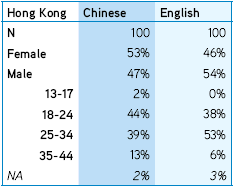
Table 13
As with the Chinese sample, over 80% of the sample were aged 18–34 years old, but amongst those replying to the English question there were more aged 25–34 years.
Table 14 shows the responses to the question which is your main website.

Table 14
The Alexa data indicates that Yahoo! should be the strongest site. However, this particular test proved to be almost too easy to replicate. About 90% of all respondents said Yahoo! was their main site.
Experiment 2 confirms the findings from Experiment 1, but does not take us much further forward.
Experiment 3 – Language Expectations
This experiment created a benchmark for expectations on the use of English and Chinese in the future. A further set of results will be collected before the presentation in April, and it is planned to collect future readings at a later date as part of this ongoing project.
The experiment originally comprised eight cells of 100 interviews. The cells were an interlace of four countries: Australia, China, and Hong Kong, and Singapore, with languages English and Chinese (Mandarin in China, Singapore, and Australia, and Cantonese in Hong Kong).
The experiment was conducted as a Facebook Poll and the question was
“In 2009 do you think most of the websites YOU will use will be:”.
The answer options were:
In English
In Chinese
mix of English and Chinese
Other
Despite the design having eight cells, the data only contain about 6.5 cells. The Mandarin questionnaire in Australia attracted very few responses (eight by the time Facebook killed it because of its poor response rate). The Mandarin cell in Singapore also ran into Facebook's quality control mechanism, and collected just 50 interviews, before it too was terminated.
Table 15 holds the demographics of the data collected in Experiment 3. Again, almost all of the respondents were aged 18–34 years old. In China the Chinese questionnaire attracted more males and fewer females.

Table 15
Table 16 shows the opinions of our respondents about the sort of websites they expect to be using in 2009.

Table 16
The first observation is that asking the question in English results in more people saying they will be using English in 2009, and asking it in Chinese results in fewer.
The second observation, which is perhaps more surprising, is that asking the question in English or Chinese has no impact on the predictions about using sites that are in Chinese in 2009.
The final point of note is the 6% in Australia who say they will be using Chinese or 50% English, 50% Chinese in 2009. Whilst this might initially be surprising, the Australian 2006 Census indicated that Chinese was the main language in 2.3% of Australian homes (1.2% Cantonese, 1.1% Mandarin), and the 2006 Census also indicated that 3.4% of Australians defined their ethnicity as Chinese. Add these to overseas students and the 6% Facebook total suddenly looks more like insight and less like an aberration.
The data from this experiment crystallised a perception which had been forming throughout the research to date. When the project commenced the authors expected differences between countries and between data sources, but what we found were differences between people which were bigger and more salient that differences between countries and languages.
In each of the countries and within each of the language groups we are finding materialists and self-actualisers, global planeteers and localists. The percentages appear to differ according to time and place, but the presence of the groups does not change from present to not present.
CONCLUSIONS
The key conclusion from this ongoing project is that so many factors are changing so fast that there is no prospect of producing definitive, enduring findings. There are things that are true today, things that are probable for tomorrow, and many things that are possible. There is also the certainty of change.
The project has only been running for a few months and no doubt it will reveal much more over the next year or two. However, we think that the project has already produced some useful indicators for the short term future of market research in Asia Pacific.
Social networks are much larger, in terms of numbers of members, than bespoke research panels and present an opportunity to reach beyond the normal range of respondents. At present social network tools are limited and the sample they generate tends to be very young, but both of these are likely to change, and change quickly. It might also be argued that the young are the most likely to be affected by marketing effort and are often the key target for many new products and communication.
As a medium for research, social networks mirror the position that the Internet itself posed in the mid to late 1990s. The samples are not representative and it is hard to be sure who is answering. The key point is not that social networks are currently unsuitable for most commercial research; the key point is that the Internet went from being an unreliable medium to the dominant growth area in research in about five years. Innovation will produce methods, be they panels or something else, which will leverage the numbers and powers of social networks and market research.
There is no clear picture whether English will continue to develop its linguistic hegemony, or whether the growth in non-English speaking users will lead to more heterogeneity. However, the strength and growth of Chinese Internet users and Chinese Internet sites suggests that both English and Chinese will be a major factor in the future of the Internet over the next five years.
Ideally, all research should be conducted in the local language, and in particular in the preferred language of the respondent – note most countries in the world have multiple languages. However, sometimes clients will find it sensible to trade-off quality against speed and cost, in order to get a result which is 'good enough' for the business problem they are seeking to solve.
It is likely that more multi-country, small sample, over-view projects are likely to be conducted in English. In particular, it is likely that international research forums and bulletin board type surveys are also likely to use an increasing amount of English, possibly with different languages forming sub-groups.
FOOTNOTE
REFERENCES
“Alternative China – The Internet in China”, The Economist, 2nd February 2008
ChinaView 29/12/2007, http://news.xinhuanet.com/english/2007-12/29/content_7336026.htm, downloaded 1/1/2008]
Liu, Melinda and Manuela Zoninsein, “These Surfers Do It Their Own Way”, Newsweek, 24/12/2007, downloaded 15/1/2008
Lu, Gang, “Old School BBS: The Chinese Social Networking Phenomenon”, Read Write Web, 17 January 2008, http://www.readwriteweb.com/archives/bbs_china_social_networking.php, downloaded 6 February 2008.
O'Reilly, Tim, “What is Web 2.0”, www.oreillynet.com, http://www.oreillynet.com/pub/a/oreilly/tim/news/2005/09/30/what-is-web-20.html, downloaded 14/1/2008
Poynter, Ray, “Can Researchers Cede Control? What Web 2.0 Means for Market Research”, Research World, July 2007.
Poynter, Ray, “Is Facebook the future of online research”, Brand Republic, 30/8/2007, downloaded 17/1/2008.
Qiang, Xiao, “Top Ten Lists: Differences Between Chinese and English Internet Users”, China Digital Times, January 17, 2008, downloaded 17/1/2008.
Sweeney, Mark, “The growing Chinese love affair with the internet”, PDA:The Digital Content Blog, 26/11/2007, downloaded 17/1/2008.
Tobin, Rick, Gord Hotchkiss, Pava Lee, “Chinese Search Engine Engagement”, Enquiro Research White Paper, January 2008, http://www.enquiroresearch.com/chinese-search-engine-engagement.aspx
 http://www.warc.com | © ESOMAR. All rights reserved |